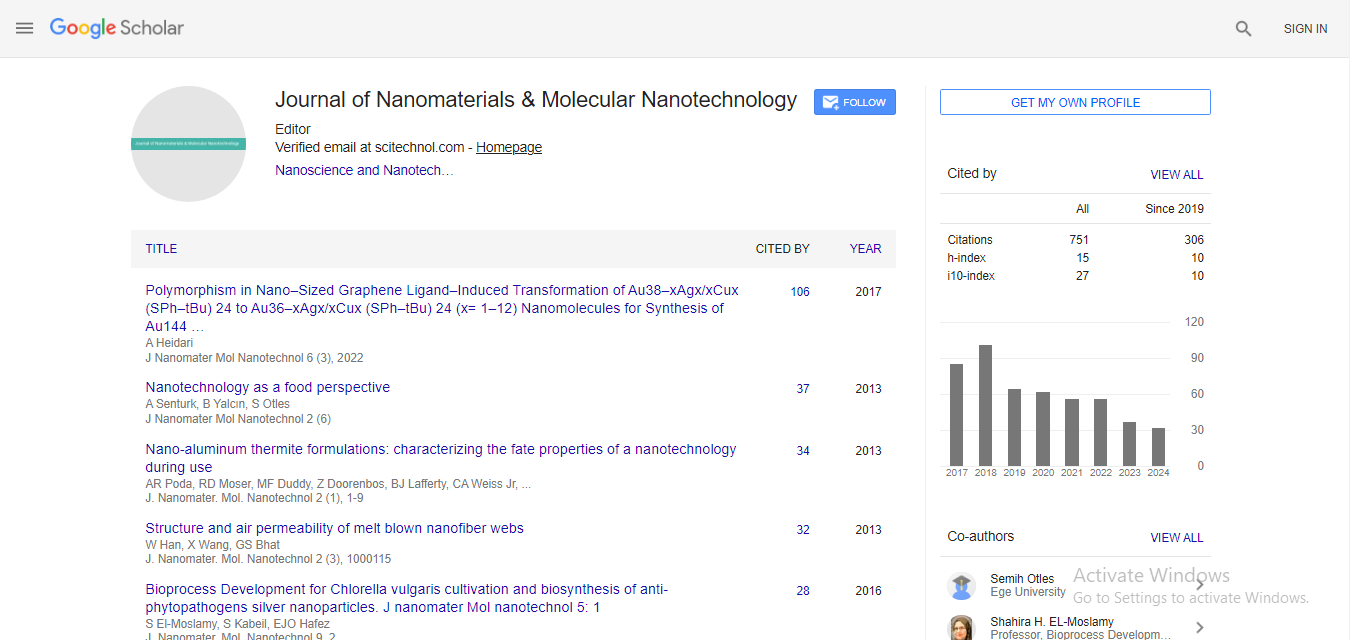Short Communication, J Nanomater Mol Nanotechnol Vol: 13 Issue: 6
Role of Nanomaterials in Environmental Remediation: Pollution Control and Water Purification
Ali Obaid*
1Department of Materials and Metallurgical Engineering, Amirkabir University of Technology,Tehran, Iran
*Corresponding Author: Ali Obaid,
Department of Materials and Metallurgical
Engineering, Amirkabir University of Technology,Tehran, Iran
E-mail: oba.a23@aut.edu.ir
Received date: 22 November, 2024, Manuscript No. JNMN-24-156127;
Editor assigned date: 25 November, 2024, PreQC No. JNMN-24-156127 (PQ);
Reviewed date: 09 December, 2024, QC No. JNMN-24-156127;
Revised date: 16 December, 2024, Manuscript No. JNMN-24-156127 (R);
Published date: 24 December, 2024, DOI: 10.4172/2324-8777.1000439
Citation: Obaid A (2024) Role of Nanomaterials in Environmental Remediation: Pollution Control and Water Purification. J Nanomater Mol Nanotechnol 13:6.
Abstract
Description
The rapid industrialization and urbanization of recent decades have led to increased environmental pollution. Water contamination, air pollution and soil degradation pose threats to ecosystems and human health. Traditional remediation technologies, while effective, often fall short in terms of efficiency, cost and scalability. Nanomaterials, owing to their nanoscale dimensions and exceptional surface to volume ratios, offer innovative solutions for environmental cleanup. Their high reactivity, tunable properties and multifunctionality make them ideal candidates for addressing complex environmental issues [1-3].
Metal-based nanomaterials, such as TiO2, Fe3O4, ZnO and silver nanoparticles, are widely used for environmental cleanup. These nanomaterials possess photocatalytic and antimicrobial properties that facilitate the degradation of organic pollutants, disinfection of water and removal of heavy metals. Titanium dioxide (TiO2) nanoparticles exhibit strong photocatalytic activity under UV light, leading to the breakdown of organic contaminants into harmless byproducts [4,5].
Graphene, Carbon Nano Tubes (CNTs) and activated carbon nanomaterials have gained attention due to their large surface areas, excellent adsorption capabilities and chemical stability. They are effective in removing heavy metals, organic pollutants and persistent contaminants from water. Carbon Nano Tubes (CNTs) can adsorb heavy metals like lead (Pb) and arsenic (As) through surface interactions and functionalization. Polymeric nanoparticles and nanocomposites, often functionalized with specific groups, enable targeted pollutant removal. These materials are cost-effective and provide flexibility in designing efficient remediation systems. Functionalized polymeric nanofibers have been used for the adsorption of dyes, heavy metals and pharmaceuticals from industrial wastewater [6,7].
Nanomaterials with high surface areas and tunable pore structures adsorb contaminants through physical or chemical interactions. For instance, graphene-based nanomaterials efficiently adsorb heavy metals and organic pollutants. Semiconductor nanomaterials, such as TiO2 and ZnO, facilitate photocatalytic reactions under light exposure. The generation of Reactive Oxygen Species (ROS) leads to the oxidative degradation of organic pollutants and microbial disinfection [8].
Zero-valent iron (nZVI) nanoparticles promote reduction reactions that convert toxic contaminants, such as hexavalent chromium (Cr(VI)), into less harmful forms. Nanomaterial-incorporated membranes (e.g., polymeric membranes with CNTs) enhance filtration efficiency for water purification by improving mechanical strength and selectivity. Water pollution, caused by heavy metals, organic contaminants and pathogens, is important environmental issue. Nanomaterials have shown remarkable efficiency in addressing this challenge. CNTs, graphene oxide and iron oxide nanoparticles effectively remove lead, cadmium and arsenic through adsorption and redox mechanisms. photocatalysts such as TiO2 degrade pesticides, pharmaceuticals and industrial chemicals in water. Silver nanoparticles and TiO2 nanocomposites exhibit antimicrobial activity, ensuring the disinfection of water supplies [9].
Nanomaterials are used in filters and catalytic systems to remove airborne pollutants. Volatile Organic Compounds (VOCs) are TiO2 photocatalysts convert VOCs into CO2 and water. Nanofiber membranes trap fine particles (PM2.5 and PM10) effectively. Nanoscale zero-valent iron (nZVI) particles are applied to contaminated soils for the immobilization and degradation of pollutants, such as heavy metals and organic compounds [10]. The long term fate of nanomaterials in the environment and their potential ecotoxicity remain concerns. Developing cost effective and scalable synthesis methods is important for real world applications. Regulatory frameworks for nanomaterial usage in environmental remediation need to be established. Future research should focus on designing ecofriendly nanomaterials, improving reusability and integrating nanotechnology with existing remediation systems.
Conclusion
Nanomaterials represent a transformative solution for environmental remediation, particularly in pollution control and water purification. Their unique properties, including high reactivity, adsorption capacity and photocatalytic activity, make them effective in removing contaminants from water, air and soil. However, addressing challenges such as toxicity, scalability and regulation is essential to ensure their safe and widespread use. Continued research and innovation, nanomaterials hold the potential to contribute significantly to a cleaner and more sustainable environment.
References
- Williams JE (2022) Novel Nano-Based Antibacterial Therapeutic Against Hospital Acquired Infection. East Carolina University.
- Simeonidis K, Mourdikoudis S, Kaprara E, Mitrakas M, Polavarapu L (2016) Inorganic engineered nanoparticles in drinking water treatment: a critical review. Environmental Science: Water Research & Technology. 2(1):43-70.
- Li Q, Mahendra. S (2008) Antimicrobial nanomaterials for water disinfection and microbial control. Environmental Science & Technology, 42(7), 2294–2301.
- Malsch NH (2005) Biomedical nanotechnology. Crc Press.
- Sharma VK (2009) Silver nanoparticles: Green synthesis and their antimicrobial activities. Adv Colloid Interface Sci, 145(1-2), 83–96.
- Wang, S, Peng Y (2010) Natural zeolites as effective adsorbents in water and wastewater treatment. Chem Engine Jour, 156(1), 11–24.
- Mohan, D, Pittman CU (2007) Arsenic removal from water/wastewater using adsorbent a critical review. J Hazard Mater, 142(1-2), 1–53.
- Savage N & Diallo MS (2005) Nanomaterials and water purification: Opportunities and challenges. J of Nanopar Res, 7(4-5), 331–342.
- Zhang WX (2003) Nanoscale iron particles for environmental remediation: An overview. J of Nanopar Res, 5(3-4), 323–332.
- Peng C, Zhang W, Gao H, Li Y, Tong X, et al. (2017) Behavior and potential impacts of metal-based engineered nanoparticles in aquatic environments. Nanomaterials. 7(1):21.
 Spanish
Spanish  Chinese
Chinese  Russian
Russian  German
German  French
French  Japanese
Japanese  Portuguese
Portuguese  Hindi
Hindi 



